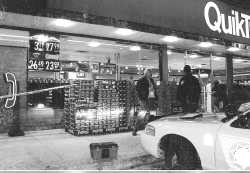At the Hands of a Stranger (35 page)
Read At the Hands of a Stranger Online
Authors: Lee Butcher
“The state calls Mrs. Emma Blount.”
When Emma Blount, Cheryl Dunlap's aunt, stepped to the microphone to read her statement to Judge Hankinson, it was immediately apparent that she was very emotional and would not have an easy time maintaining her composure.
“This is the hardest thing I've had to do,” she said before beginning to read her letter.
“âI'm Cheryl's aunt,'” she began. “âCheryl's mother was in a nursing home at the time Cheryl was murdered, and when she was told what had happened, she withdrew,'” Blount said. “âShe died thirteen months later.'”
Blount went on to tell of Cheryl's work with patients and family members at the nursing home, and said Cheryl had told her of going often to the forest.
“âShe said she was safe at the National Forest,'” Mrs. Blount said in a choked voice.
“âShe was compassionate, loving, quick to help, and loved mission work. She had worked hard to complete nursing school. Her children have been cheated out of her love and devotion,'” Blount told the judge, growing more emotional. “âShe was always happy and smiling.'”
At this point several people on the message board noticed and commented that the court reporter appeared to be crying as she steadily continued taking notes.
Â
Cheryl's best friend, Laura Walden, was next to read her letter: “âI miss her smile, her laugh; she was a friend, a sister, a counselor, and a shoulder to cry on. When I realized she was gone, I felt empty and void. I loved and respected her because of her honesty, integrity and loyalty that never wavered. I depended on her to be there. I miss her terribly; she was gone too soon. May her light continue to shine brightly in those of us she touched.'”
Â
Gloria Tucker, Cheryl's cousin, was the last to read her letter to the judge: “âCheri had so much compassion for people. She went to her patients' homes after their benefits had run out, and she went to disaster areas to help people.'”
Tucker then spoke powerfully about the crime that took her cousin's life: “âShe must have been so afraid and lonely during that time with Hilton. Hilton sentenced his victims to death. What will it take to stop him? The solution is to carry out the sentence speedily. He must pay with his own life.'”
Robert Friedman immediately rose to his feet. “Parts of the last victim impact statement we object to, specifically the mention of terror, captivity, death sentence, et cetera.”
Judge Hankinson then pointed something out to Friedman that he should probably have realized earlier.
“All you're doing is repeating these things for me to hear again,” the judge told him. He asked Friedman if his client wished to speak, and Friedman told him that Hilton did not.
Â
Then it was time for the state to give their final argument for the death penalty to be imposed.
Willie Meggs told the judge, “The state doesn't ask the court to impose the death penalty lightly. There are six aggravating factors to consider.”
Meggs then listed the six factors:
- Hilton previously confessed to Meredith Emerson's murder;
- Cheryl Dunlap's murder was done during the commission of a planned kidnapping;
- The murder was done to avoid arrest, according to Hilton's own statement, and great pains were taken to avoid Cheryl Dunlap being identified;
- The murder was done for financial gain;
- The crime was heinous, atrocious, and cruel, with “cognition of impending death by the victim in the case,” and was wicked, vile and pitiless;
- The crime was cold, calculated, and premeditated. “He had a plan, detailed his plan, had time to reflect on his activity.”
“Your Honor, the state feels the jury's recommendation [of the death penalty] should be given great weight. We hereby ask the court to impose the death penalty in this case.”
When Robert Friedman stood up to tell the judge of the statutory and nonstatutory mitigating circumstances in Gary Hilton's case, he was ready to pull out all the stops in an effort to save his client from the death penalty.
The statutory mitigating circumstances, Friedman said, were the facts that Hilton was “impaired” at the time of the murder, and was under extreme stress at that time.
Friedman named a list of ten nonstatutory mitigating circumstances, which included yet another repetition of his prior claims that Hilton was raised in an abusive home, had been abandoned by his father, suffered from maternal deprivation, was put into foster care, was from a poor family, suffered a brain injury, and had severe mental defects.
The defense attorney also told the judge that “no weight should be given to the âavoiding arrest' aggravating circumstances.” He said that the state was relying on what occurred in the Emerson murder.
“Much of the state's presentation is replete with errors and factual inaccuracies,” Friedman said. “The DNA evidence, the medical examiner's statement ⦠speculation, relying on Emerson and inaccurate facts.
“The court should give no weight” to the state's arguments, Friedman said. “The mitigation clearly outweighs the aggravation in this case. The court should impose a life sentence.”
Judge Hankinson sat for a moment, considering the situation.
“I don't particularly want to hear more,” he said. “Does the state have more?”
Both sides told the judge they did not have anything further.
“The next session of this court will be held on Thursday, April twenty-first, at ten
A.M
.,” Judge Hankinson said. “We are recessed till then.”
As everyone rose to leave the courtroom, Hilton leaned over, patted Friedman on the back, and said, “Hey, good job.”
Â
When sentencing day came, there was a larger crowd waiting in the courtroom than there had been on many days of the trial. Cheryl Dunlap's aunt, cousin, and other friends and relatives were present, along with the Leon and Wakulla County sheriffs and many of the other law enforcement personnel who had been closely involved in the case for so long.
Gary Hilton entered the courtroom several minutes early, cuffed and shackled and wearing jail clothing. He was immediately surrounded at the defense table by his attorneys. Ines Suber sat down beside him and spoke to him intently, leaning in closely. Hilton smiled, nodded, and looked relatively relaxed as he turned around to see the spectators and looked directly at the TV cameras. If he was apprehensive about his sentencing, he did not show it at that time.
Judge Hankinson entered the courtroom. After stating for the record the purpose of the hearing, he said, “Some judges have read their entire sentencing orders, but I don't think that's necessary today. I have written my orders and copies will be provided to both sides.”
Hankinson then told the court that he was prepared to give his order.
“Mr. Hilton, rise, please.”
Hilton stood up, along with his defense team.
“âThe court has considered and weighed the aggravating and mitigating circumstances in this case, and the court finds, as did the jury, that the aggravating circumstances outweighed the mitigating circumstances.
“âAccordingly, it is ordered and adjudged that you, Gary Michael Hilton, be sentenced to death for the murder of Cheryl Dunlap. This sentence is subject to automatic reviews by the Florida Supreme Court.'”
Hilton, for the first time, showed some small sign of emotion, blinking rapidly.
“Mr. Hilton, you have thirty days to file an appeal.
“May God have mercy on your soul.”
The judge ordered Hilton to be fingerprinted in the courtroom; then he was immediately taken out by his escort of deputies. There was complete silence in the courtroom for a moment; then the observers quietly began to leave. Some of Cheryl Dunlap's family wiped their eyes; others smiled. There was no air of celebrationâonly a quiet vindication.
Leon County sheriff Larry Campbell called Hilton a remorseless, calculating person who had come “shuffling into court like he's some poor little old grandfather, and he's not. He's a damned monster.”
Cheryl Dunlap's cousin Gloria Tucker said she had been certain the judge would impose the death penalty, and was happy that Hilton would not be able to hurt anyone else. Cheryl's aunt Emma Blount said it was a relief that Hilton would never be able to harm anyone else's child.
“Cheryl was completely, totally committed to God, so I know she's in Heaven,” Blount said.
Â
After years of delay it finally had taken only six minutes for justice to be received for Cheryl Dunlap. Hilton left the courtroom, however, very much aware that yet another family, another community, and another large contingent of friends from around the nation would be waiting for him in North Carolina, ready to seek a similar verdict in the murders of John and Irene Bryant.
Gary Michael Hilton's time in court was far from over.
The police didn't know whether Meredith Emerson was alive or not during their massive search for her. They were hot on her abductor's trail and prayed that, with a little bit of luck, they would catch up before it was too late to save her. The police actually had come face to face with Meredith's abductor on a couple of occasions but had no way of knowing who he was. Or that he had any connection with the missing young woman.
The search for Meredith's abductor melded into searches for a murdered North Carolina Couple, and the abduction and killing of Cheryl Dunlap, a beloved missionary/nurse in North Florida. The U.S. Coast Guard, U.S. Park Service, the Georgia Bureau of Investigation (GBI), Federal Bureau of Investigation (FBI), and dozens of police and volunteer agencies scanned a five-state area from the air, ground and under the water. Thousands of volunteers from the Rocky Mountains in the west to the beginning of The Appalachian Trail in Maine were on the look-out for the missing people.
It was a huge effort, and naming everyone who was instrumental in the creation of this book would go on and on. I would like to extend special thanks to Special Agent Clay Bridges of the GBI who gave several lengthy interviews to the author, and who made sense of a time-line and search that drew from such wide and varied sources. Special thanks to Stephanie Finnegan for superb copy editing, Richard Ember for encouragement, and to the always up-beat, inventive, and empathetic Michaela Hamilton, Executive Editor of Kensington Publishing Corp., who makes it all work.
Health issues made it impossible for me to attend Gary Hilton's trial or to write anything after that. The task of completing this book was thrown unexpectedly to Sheila Johnson, a Pinnacle true crime writer, who picked it up in mid-stride and continued seamlessly to the finish line. Sheila shares authorship of this book, even though she modestly downplays her role. Thanks to Sheila and all of the others who contributed their time, thoughts, and well wishes.
Lee Butcher
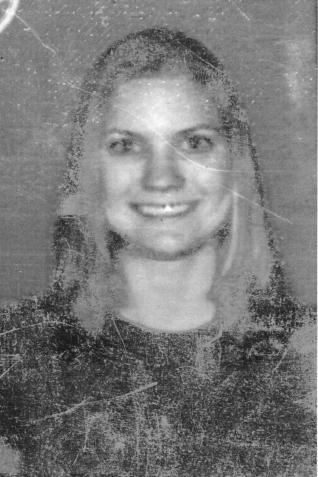
Meredith Emerson's driver's license with her photo was among the evidence found in Hilton's van.
(Photo courtesy of GBI)
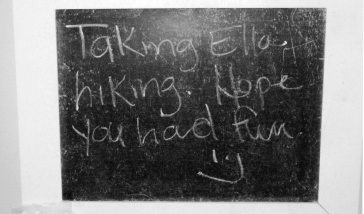
Emerson left this note for her roommate on a chalk board to tell her she had gone hiking.
(Photo courtesy of GBI)
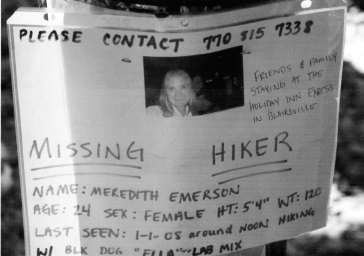
One of the many missing posters used during the massive search of more than 64,000 acres of Dawson Forest in an attempt to find the missing hiker.
(Photo courtesy of GBI)
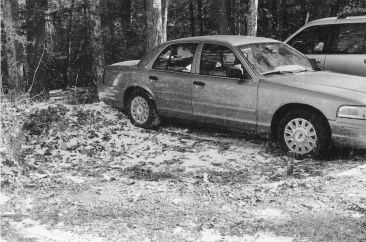
Emerson's abandoned car at Vogel Park, where Hilton imprisoned the young woman in his own vehicle.
(Photo courtesy of GBI)
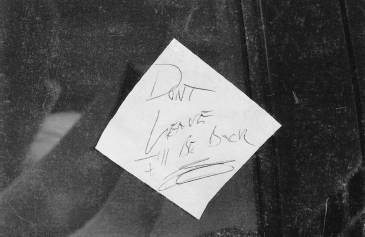
A Post-it note was placed on Emerson's car after her boyfriend found the abandoned vehicle on January 2, the day after Emerson was kidnapped.
(Photo courtesy of GBI)
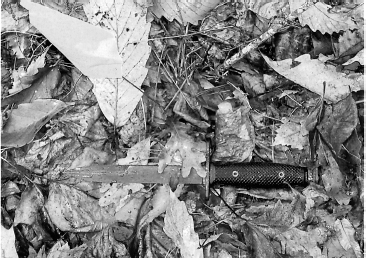
The bayonet Hilton used when he attacked Emerson. She fought back and knocked the bayonet from Hilton's grip.
(Photo courtesy of GBI)
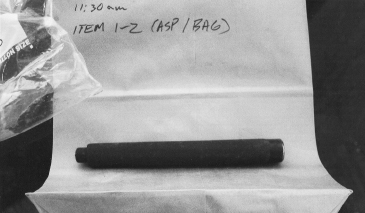
The collapsible baton Emerson forced from Hilton during their struggle was bagged as evidence in as many as three murder investigations.
(Photo courtesy of GBI)

Eyeglasses belonging to Emerson were found off the trail where she fought Hilton.
(Photo courtesy of GBI)
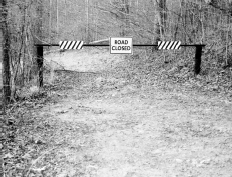
Hilton chose a remote, blocked road to drive to the campsite where he murdered Emerson after three nights of holding her captive.
(Photo courtesy of GBI)

The site where Emerson's body was found in the deep woods after evidence was gathered.
(Photo courtesy of GBI)
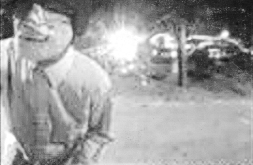
Wearing a homemade mask, Hilton tried to use Emerson's ATM card five times but she gave him false PIN numbers.
(Photo courtesy of GBI)
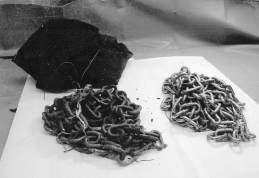
Emerson was held captive most of the time in heavy, rusty chains that were padlocked and welded to the van's steel floor.
(Photo courtesy of GBI)
